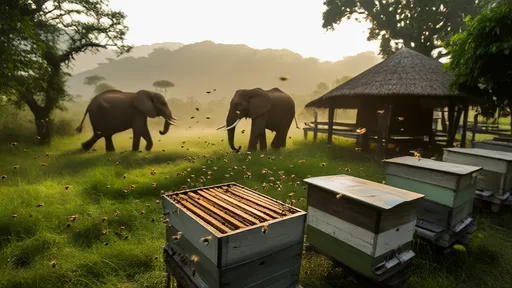In the heart of rural Africa and parts of Asia, a quiet revolution is taking place at the intersection of agriculture and wildlife conservation. Farmers who have long battled the destructive incursions of wild elephants into their crops are discovering an unlikely ally: bees. The innovative concept of "zero-conflict farming" through beehive fences is transforming age-old conflicts into harmonious coexistence, proving that nature often holds the key to its own balance.
The idea is as elegant as it is effective. Elephants, despite their size and strength, have a well-documented fear of bees. African honeybees in particular are known to swarm aggressively when disturbed, stinging the sensitive areas around elephants' eyes and trunks. This natural deterrent has been harnessed through the creation of beehive fences—lines of interlinked hives suspended between posts around farm perimeters. When elephants attempt to pass through, they inevitably disturb the hives, triggering defensive bee behavior that sends the giants retreating.
Dr. Lucy King, head of the Human-Elephant Co-Existence Program at Save the Elephants, pioneered this approach after years of research. "What began as a curious observation about elephant behavior has grown into a sustainable solution benefiting both wildlife and farming communities," she explains. Field studies in Kenya demonstrated that beehive fences deterred elephants successfully in over 80% of attempted raids, with the added benefit of pollinating nearby crops and providing honey as an alternative income source.
The implementation of these fences reveals fascinating insights into elephant intelligence. Younger elephants, having learned from painful encounters, become particularly cautious around the hives. Some farmers report seeing matriarchs leading herds on lengthy detours to avoid the buzzing sentinels. This learned behavior creates generational knowledge within elephant families, reducing conflicts over time without the need for harmful deterrents like gunfire or sharp barriers.
Beyond conflict prevention, the beehive fences are sparking economic transformation in participating communities. A single fence can produce 50-100 liters of honey annually, with farmers' cooperatives forming to process and market the product. In some regions, "elephant-friendly honey" commands premium prices, creating a direct financial incentive for conservation. The additional pollination services boost crop yields by up to 30%, compounding the benefits for food security.
Technical adaptations have emerged as the concept spreads across different regions. In Sri Lanka, where the larger Asian elephants roam, designers created heavier-duty hives capable of withstanding monsoons. Tanzanian farmers developed movable fence sections to accommodate seasonal grazing patterns. These localized innovations demonstrate the flexibility of the core concept while addressing unique ecological and cultural contexts.
The psychological impact on farming communities has been profound. Where once nights were spent in fearful vigilance, families now rest easier knowing their livelihoods are protected. Children previously kept home to guard fields can attend school regularly. The shift from confrontation to coexistence has opened dialogues about broader conservation efforts, with many farmers becoming active participants in habitat protection initiatives.
Challenges remain, of course. Maintaining healthy bee colonies requires training and resources that aren't always readily available. Drought conditions can stress both bees and elephants, sometimes altering normal behavior patterns. Researchers continue refining designs, exploring supplemental deterrents like chili-infused ropes for periods when bee activity decreases. Yet the overwhelming success stories continue to inspire new implementations across elephant ranges.
Perhaps the most beautiful aspect of this solution lies in its simplicity. By understanding and working with natural behaviors rather than against them, humans have found a way to protect their crops without harming the magnificent creatures who share the land. As climate change and habitat loss intensify pressures on both agriculture and wildlife, such nature-based solutions offer hope for balanced ecosystems where all species can thrive.
The beehive fence movement continues to grow, with projects now established in 15 countries across Africa and Asia. Conservation organizations provide training programs, helping communities build and maintain their defenses while monitoring elephant movements. Each new successful implementation adds to the body of evidence that coexistence isn't just possible—it's practical, profitable, and profoundly beneficial for all involved.
Looking to the future, researchers speculate about expanding the concept. Could similar natural deterrents work for other wildlife conflicts? Might the principles of zero-conflict farming apply to challenges with different species? For now, the humble honeybee stands as proof that sometimes the smallest creatures hold the power to resolve our biggest challenges, one buzzing hive at a time.

By /Jul 7, 2025

By /Jul 7, 2025

By /Jul 7, 2025

By /Jul 7, 2025

By /Jul 7, 2025

By /Jul 7, 2025

By /Jul 7, 2025

By /Jul 7, 2025

By /Jul 7, 2025

By /Jul 7, 2025

By /Jul 7, 2025

By /Jul 7, 2025

By /Jul 7, 2025

By /Jul 7, 2025

By /Jul 7, 2025

By /Jul 7, 2025

By /Jul 7, 2025

By /Jul 7, 2025